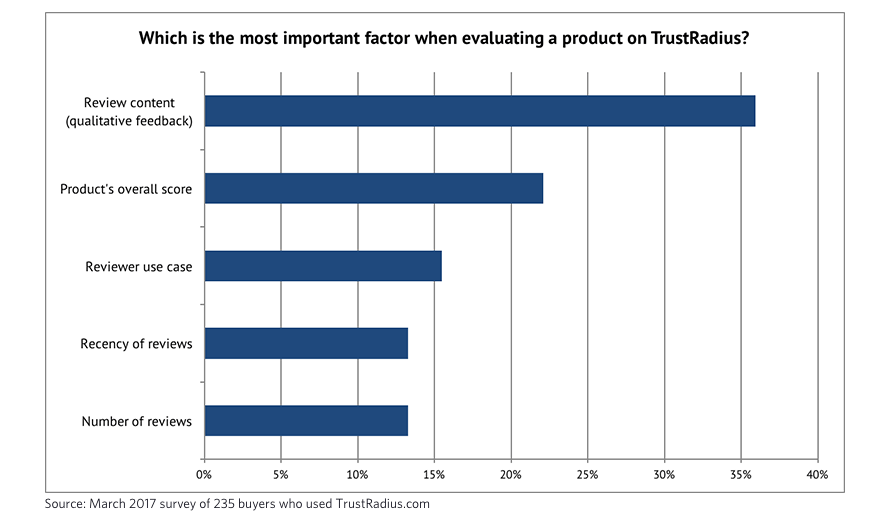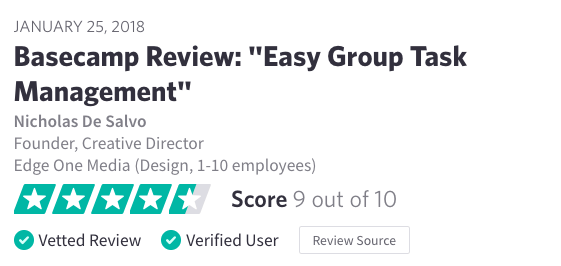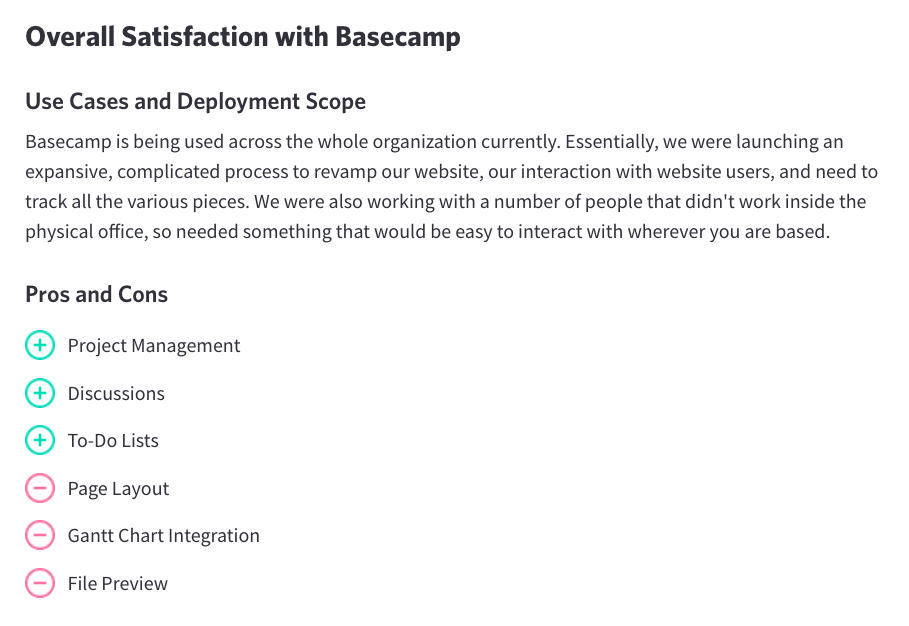How to Spot a Fake B2B Review
There has been an explosion of news coverage around fake consumer reviews. As product reviews play an increasingly important role in buyers’ decision-making process, sellers are doing what they can to play the game—or game the system.
Recent stories by BuzzFeed and the Washington Post dig into fake review schemes that Amazon sellers can (and sometimes must) buy into, paying for a slew of 5-star reviews of their product—or 1-star reviews of competitors’ products. For certain types of products on Amazon, as few as 33% of reviews of the top 10 products appear legitimate, according to an analysis in the above Washington Post article using data from ReviewMeta, a website that helps consumers spot unnatural Amazon reviews.
The BuzzFeed article says, “Paid review writing is the modern lemonade stand.” The price per fake review can start small, but it adds up. At scale, the fake review hustle has a big impact on which product consumers buy. It costs sellers who are locked in an arms race, and consumers who choose the wrong product based on fake reviews.
If you read through the comments on the above articles or others like them, you’ll find many stories that go just like this: “I bought such-and-such product based on the outstanding reviews. The product turned out to be a piece of crap. I returned it, and looked further into the positive reviews, and realized they were clearly fake. Now whenever I buy something online, I dig into the reviews to pick out what’s real.”
The recent exposes have been centered around reviews of consumer products. But for a while now, business purchasing behavior has been becoming more consumer-like, and reviews are a part of this trend.
Do I need to be worried about B2B reviews?
User reviews are more recent, though now thoroughly established, in the B2B industry. Review sites like TrustRadius collect and display user reviews of software, hardware and services sold to businesses.
There are still vast differences in scale between B2B and B2C review sites. Based on ReviewMeta estimates, Amazon likely hosts around 250 million reviews. Yelp has 150 million. TripAdvisor has 600 million. B2B technology reviews sites have something more like 1 million reviews all together.
Being newer, and smaller in scale by orders of magnitude, B2B reviews aren’t facing the rampant fake reviews news coverage. But there are a few reasons for B2B buyers to use a discerning eye when looking at reviews.
In B2B, the stakes are higher
Consumers duped by fake reviews can usually return the product for a full refund—no harm, no foul. At worst, a bad consumer purchase might lead to a waste of money, or a waste of time, or maybe even a ruined vacation…but certainly not a ruined career.
For B2B, a software purchase decision can commonly be in the range of $50k to even $100k or $1M per year. Given the significant investment of both time and money in implementing new systems, you definitely don’t want to make the wrong decision.
So it’s paramount that B2B buyers learn to recognize inauthentic, biased or problematic reviews out there.
In B2B, paid is not more biased
To try to ensure reviews are authentic and unbiased, many consumer sites have gone the route of banning the use of incentives, or in the case of Yelp, even prohibiting businesses or third parties from asking customers to write reviews. The impetus was based on data that showed offering rewards or free products in exchange for reviews resulted in higher ratings. (This backfired: the effect was to drive the paid review practice underground, leading to fake reviews.)
In the B2B world, the patterns we see are, in fact, the opposite. Invitations with small incentives actually lead to a larger, more representative sample, a more even distribution of ratings (not just promoters and detractors), and more detailed B2B reviews. This is because thank-you rewards help reduce participation bias. In short, relying on self-motivation in B2B leads to overrepresentation of the most extreme viewpoints. Rewards bring in more common sentiments.
In B2B, the motivations are different
Fake reviews in the B2C world are purchased by sellers trying to drive up their own score or drag down those of competitors. In other words, fake reviews are about influence, whether it’s a seller with a bad product or a legitimate seller that needs to participate in this arms race to keep up their sales.
This kind of scenario — fake reviews intended to influence scores — is extremely rare in B2B. A more common practice is vendor-driven selection bias, where B2B vendors try to drive up their scores with cherry-picking by asking only their happiest customers to write reviews. Here is a post with information about how TrustRadius combats this practice, and how to watch out for it on other review sites.
In the rest of this post, we’ll explain where fake reviews do come from in B2B, and how to identify them.
What is truly fake in B2B?
Because B2B review sites themselves regularly offer independent thank-you rewards for reviews, they actually face a different kind of fake review challenge: individuals trying to rack up gift cards by creating multiple fake profiles, or reviewing products they’ve never actually used.
Since it’s not driven by vendors, this kind of activity may not have an impact on star ratings, but it results in misleading or false qualitative content. And since choosing a B2B product is all about figuring out the right fit for your situation, B2B buyers care more about the qualitative review content than they do the scores.

TrustRadius has many measures in place to prevent this kind of activity. But not all review sites are successful at stamping out fake reviews.
There are a few things you can watch out for yourself when reading a review to help determine how much you can trust it. At TrustRadius, we go through these steps ourselves, in addition to other prevention mechanisms available to us on the back-end. Understanding our process can help you understand how much you can trust reviews on TrustRadius, and look at other review sites with a more discerning eye.
In general, if you’re looking at a review that’s extremely detailed and useful, it’s almost certainly real. But if you’re reading a review that seems somewhat shady, then you can try a few of these tips to figure out the authenticity of the review or the review site in general.
Steps to determining a B2B review’s authenticity
1. Vet the reviewer
If the reviewer is named, there are a few tactics you can use to suss out how much you should trust their perspective.
Check out their profile on the review site
First, check out their profile on the review site itself. How many products have they reviewed? Do those products build a meaningful story? Do they fit the reviewer’s title and role? Or, have they simply reviewed a bunch of products that are ubiquitous and don’t really fit together?
There’s no smoking gun here. You’re simply looking for how unique and believable the profile is.
Google search their photo
Second, do a lookup on their photo. If you’re using Chrome, right-click, and select “Search Google for Image”. This will help you discover whether they co-opted someone else’s photo for their profile—an almost sure sign that they’re a phony out for gift cards.
On TrustRadius, we’ve seen fake reviewers use photos of everything from actors to famous investors to chefs to random Instagrammers. Photographers’ websites, which are often captioned with the real name, are another common source of co-opted photos.
Find the reviewer on LinkedIn
Finally, find the individual on LinkedIn or even other social networks. On LinkedIn, you can check out the number of connections, the employment history, recommendations, etc. Check out the company the reviewer currently works for. Is it a real company? Do they have a website? Sometimes fake reviewers will use made-up companies for their employment.
Note that a thin LinkedIn profile (i.e., someone with few connections or only one job) doesn’t necessarily mean it’s a fake person. Consider the industry or geography: Is it someone who works in an industry or lives in a country where usage of LinkedIn might not be so prominent?
All three of these things will help weave the story for you. And remember, TrustRadius does all of these things ourselves, before we publish a review. But when it comes to other review sites, these are only options if the reviewer’s identity is revealed.
Even with anonymous reviews, you can do some sleuthing based on the review itself.
2. Vet the review
The content of the review itself may, in fact, be your best indicator of authenticity.
Look for use case details
What you’re looking for is quality and level of detail. The storyline around how the individual uses the product is often the best place to look. Topics like pros & cons can easily be copied from other reviews or other sources and re-worded. But unique and specific details around use case are much harder to co-opt.
To mention two extremes, what you don’t want is a use case that just says what the product does. For example, this is a quote from a fake review we didn’t publish on TrustRadius: “Basecamp is the best project managing application in market. Simple, designed good, easy to navigate and simple to setup and start to first projects and events. You can easily track your projects and events and customize them as groups.”
What you do want is specific information that’s likely unique to that reviewer. One, this helps confirm authenticity. Two, it helps you understand how relevant the review is for your own desired use case.
This legitimate review of Basecamp has a highly specific use case answer:
Check the rest of the review for detailed insights
The use case question certainly isn’t the only place to look. Unique detail and consistent writing style in the rest of the review can good signs of authenticity.
On TrustRadius, the Cons can be oddly specific, as well as the review’s title, ROI answer, or comparisons to Alternatives.
Check for plagiarism
If you’re in doubt about a review, another good trick is to pick out questionable statements from the review to do an exact match Google search using quotation marks. This will help surface whether the parts of the review were copied from other online sources, which is a sign of inauthenticity.
3. Vet the product
Often fake reviewers will build multiple fake profiles to capitalize on product-specific offers they’ve received from the review site. So fake reviews may cluster around specific products.
If you suspect a review might be fake, check out other reviews of the same product from the around same time period. Are they eerily similar? Do they all share a lack of detail, or only provide detail on the exact same one or two features?
If so, they may be a string of fake reviews. If you see something like this on TrustRadius, let us know! We vet every reviewer and review before publication, but we’re happy to take another look if something seems fishy to you. Just email your tip to research@trustradius.com.
4. Vet the review site
B2B review sites have varying levels of quality control in place. You’ll probably see visual cues like “verified” or “validated” on every review (similar to the image below), but you’ll want to dig into more specifics.

You may want to look for something like a set of community guidelines or a set of quality control standards, probably in the site footer or the company’s About Us section. Determine for yourself whether those practices seem up to snuff, or whether you want to do some of your own sleuthing as well.
Finally, it’s always best practice to check the site’s business model. If you’re using the site as a third-party resource, and you’re not paying them, how do they make their money? Make sure they have a model that doesn’t smell like pay-for-play or encourage unfair treatment of different vendors. Here’s a description of our business model at TrustRadius.
More importantly, watch out for other types of bias
While fake reviews are not rampant in B2B, the stakes of picking the right (or wrong!) product are extremely high. These tips should go a long way in helping you figure out which reviews are from real users.
But as we mentioned earlier, fake reviews aren’t necessarily the most important thing for you to be aware of. What’s even more common in B2B reviews is cherry-picking, or sampling bias. Cherry-picking is when B2B vendors overwhelm review sites with reviews from only the happiest customers. These are real users, with real feedback to offer. However, the end result makes it look like the product is all rainbows and unicorns, when the reality for the average user may be different. An entire slice of customers with middle-of-the-road sentiment might be missing or underrepresented. So make sure you learn how to watch out for cherry-picking on review sites as well.
Was this helpful?

